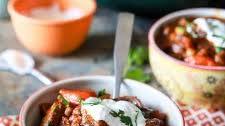The Flavours of Morocco: Authentic Moroccan Lamb Stew
When it comes to hearty and flavourful dishes, few can rival the richness of Moroccan cuisine. One iconic dish that embodies the essence of Moroccan cooking is the authentic Moroccan lamb stew. Bursting with spices, tender meat, and a symphony of flavours, this stew is a true delight for the senses.
Ingredients:
- 500g lamb shoulder, cubed
- 2 onions, finely chopped
- 3 garlic cloves, minced
- 2 tomatoes, diced
- 1 tablespoon ras el hanout spice mix
- 1 teaspoon ground cumin
- 1 teaspoon ground coriander
- 1 cinnamon stick
- Handful of dried apricots, chopped
- Handful of almonds, toasted
- Salt and pepper to taste
- Fresh coriander leaves for garnish
Instructions:
- In a large pot, heat some olive oil over medium heat. Add the onions and garlic, sauté until soft.
- Add the cubed lamb shoulder to the pot and brown on all sides.
- Sprinkle in the ras el hanout spice mix, cumin, coriander, salt and pepper. Stir well to coat the meat.
- Add the diced tomatoes and cinnamon stick to the pot. Pour in enough water to cover the meat.
- Cover the pot with a lid and let simmer on low heat for about 1.5 to 2 hours or until the lamb is tender.
- Add chopped dried apricots and toasted almonds to the stew. Let it simmer for another 15 minutes to allow flavours to meld together.
- Taste and adjust seasoning if needed. Serve hot garnished with fresh coriander leaves.
This authentic Moroccan lamb stew is best enjoyed with a side of couscous or crusty bread to soak up all the delicious juices. With each spoonful, you’ll be transported to the bustling souks of Marrakech or the serene Atlas Mountains—wherever your imagination takes you in magical Morocco.
Understanding Authentic Moroccan Lamb Stew: Key Ingredients, Cooking Tips, and Regional Variations
- 1. What makes Moroccan lamb stew authentic?
- 2. What are the key ingredients in Moroccan lamb stew?
- 3. How long does it take to cook authentic Moroccan lamb stew?
- 4. Can I substitute any ingredients in the traditional recipe for Moroccan lamb stew?
- 5. Is it necessary to use a specific type of lamb for this dish?
- 6. Are there any variations of Moroccan lamb stew based on different regions of Morocco?
- 7. What side dishes pair well with authentic Moroccan lamb stew?
- 8. How can I adjust the level of spiciness in the stew to suit my taste preferences?
- 9. Are there any tips for enhancing the flavours of Moroccan lamb stew?
1. What makes Moroccan lamb stew authentic?
Authentic Moroccan lamb stew is defined by a harmonious blend of traditional spices and ingredients that capture the essence of Moroccan cuisine. What sets it apart is the careful selection of spices such as ras el hanout, cumin, and coriander, which infuse the dish with a depth of flavour that is unique to Moroccan cooking. The use of tender lamb shoulder, along with dried fruits like apricots and nuts like almonds, adds a touch of sweetness and texture that is characteristic of Moroccan stews. The slow cooking process allows the flavours to meld together, creating a rich and aromatic dish that embodies the warmth and hospitality of Moroccan culture.
2. What are the key ingredients in Moroccan lamb stew?
In authentic Moroccan lamb stew, the key ingredients that contribute to its distinctive flavour profile include tender lamb shoulder, aromatic spices such as ras el hanout, cumin, and coriander, along with the sweetness of dried apricots and the crunch of toasted almonds. These ingredients come together harmoniously to create a rich and fragrant stew that is a true reflection of Morocco’s culinary heritage.
3. How long does it take to cook authentic Moroccan lamb stew?
Cooking authentic Moroccan lamb stew is a labour of love that requires patience to achieve its full flavour potential. Typically, it takes around 1.5 to 2 hours of simmering on low heat for the lamb to become tender and for the spices to infuse into the dish. This slow cooking process allows the ingredients to meld together, creating a rich and aromatic stew that is worth every minute spent tending to it. The end result is a hearty and soul-warming meal that captures the essence of Moroccan cuisine in every delicious bite.
4. Can I substitute any ingredients in the traditional recipe for Moroccan lamb stew?
When it comes to making an authentic Moroccan lamb stew, the traditional recipe holds the key to its rich and distinctive flavours. While some may wonder about substituting ingredients, it’s important to note that each component plays a crucial role in creating the unique taste of this dish. However, for those with dietary restrictions or preferences, there are some flexible options. For instance, you could consider using alternative cuts of lamb or adjusting the spice levels to suit your palate. While these substitutions may alter the dish slightly, they can still result in a delicious and satisfying stew that captures the essence of Moroccan cuisine.
5. Is it necessary to use a specific type of lamb for this dish?
When preparing authentic Moroccan lamb stew, the choice of lamb plays a crucial role in achieving the dish’s distinctive flavour and texture. While there isn’t a strict requirement for a specific type of lamb, using cuts like lamb shoulder or leg that are well-marbled with fat tend to result in a more tender and succulent stew. The richness of the meat enhances the overall depth of flavour in the dish, infusing it with a melt-in-your-mouth quality that is characteristic of traditional Moroccan cuisine. Ultimately, while you have some flexibility in selecting the type of lamb, opting for quality cuts will undoubtedly elevate the authenticity and deliciousness of your Moroccan lamb stew.
6. Are there any variations of Moroccan lamb stew based on different regions of Morocco?
Indeed, the beauty of Moroccan cuisine lies in its diversity and regional influences. Across the varied landscapes of Morocco, different regions put their own unique spin on the traditional lamb stew, resulting in a delightful array of variations. From the aromatic tagines of Marrakech to the hearty stews of the Atlas Mountains and the coastal influences in cities like Essaouira, each region offers a distinct flavour profile and ingredient combination that reflects its local culture and culinary traditions. Whether it’s the use of preserved lemons in the north or the addition of olives in the south, exploring these regional variations adds an extra layer of depth to the already rich tapestry of Moroccan gastronomy.
7. What side dishes pair well with authentic Moroccan lamb stew?
When it comes to complementing the rich and aromatic flavours of authentic Moroccan lamb stew, there are several side dishes that enhance the dining experience. Traditional options such as fluffy couscous, fragrant saffron rice, or warm flatbreads are popular choices to soak up the delicious stew juices. Additionally, a refreshing Moroccan salad with crisp vegetables and a tangy dressing can provide a contrast to the hearty stew. For those looking for a more indulgent pairing, consider serving the lamb stew with buttery roasted vegetables or a cooling mint yogurt sauce. These side dishes not only add variety to the meal but also elevate the overall taste of this iconic Moroccan dish.
8. How can I adjust the level of spiciness in the stew to suit my taste preferences?
To adjust the level of spiciness in your authentic Moroccan lamb stew to suit your taste preferences, you have a few options. Firstly, you can control the heat by adjusting the amount of ras el hanout spice mix or ground cumin added to the stew. Start with smaller quantities and gradually increase until you reach your desired level of spiciness. Additionally, you can incorporate fresh chillies or a pinch of cayenne pepper for an extra kick. Remember, it’s always best to taste-test as you go along to ensure the stew aligns perfectly with your spice tolerance.
9. Are there any tips for enhancing the flavours of Moroccan lamb stew?
For those looking to elevate the flavours of their Moroccan lamb stew, there are several tips to consider. Firstly, marinating the lamb in a mixture of Moroccan spices overnight can intensify the taste and tenderize the meat. Additionally, adding a splash of preserved lemon juice or a drizzle of honey towards the end of cooking can bring a delightful balance of tanginess and sweetness to the stew. Finally, garnishing with a generous handful of fresh herbs such as mint or parsley just before serving can add a burst of freshness that complements the rich and aromatic flavours of this classic dish.




